Tycho Brahe, Brazen Astronomer
Tycho Brahe was born as Tyge Brahe in 1546, though he would adopt the Latinized form of his first name when he was fifteen. His parents were Danish nobles, with his father, Otte Brahe, one of the close advisors of the King of Denmark. Tycho had a twin brother who died shortly after birth (something he would later write a poem about), and two sisters, one older and one younger. When he was two years old his uncle Jorgen arrived when his parents were away and kidnapped him, in accordance with a deal he had made with Tycho’s father years before. Jorgen and his wife had no children, and so they had agreed that they would adopt one of Otte’s sons and make him their heir. Since Otte had shown no sign of honouring the agreement, Jorgen took matters into his own hands. So it was that Tycho was raised not by the politician but by the scholar, setting the course for the rest of his life.
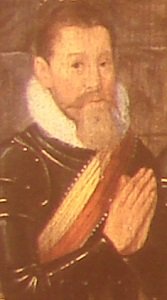
Tycho’s uncle wished him to become a lawyer, and so set him to studying law. Tycho had other ideas. On the 21st August 1560, a solar eclipse took place. Tycho was impressed not just by the eclipse but by the ability of scholars to predict that it would take place. As a result he decided to become an astronomer, much to his uncle’s dismay. To distract him from this fancy, he was sent to the University of Leipzig to study languages and culture, though he soon managed to turn his education back to astronomy. He was brought home on a sad errand, however. His uncle, who had been fighting for Denmark in a war against Sweden, had fallen ill after diving into a river to rescue Frederick, the King of Denmark. The young King survived, but the older Jorgen contracted some illness (possibly pneumonia, or a bacterial infection from swallowing tainted water) and died. Tycho would enjoy much royal favour later in life, possibly motivated by guilt from this death.
It was the following year, while touring around the universities of Germany, that Tycho gained his most distinctive feature. At a wedding dance he and another Danish noble, Manderup Parsberg, got into an argument. The exact nature of the argument is disputed – some sources give it as being over which was more skilled in mathematics, while others have it (more believably) as being about the exact solution to a mathematical problem. The two resumed the argument the next time they met, and things became so heated that on the 29th December, nearly three weeks after the original argument, the two men fought a duel. Doubtless neither meant to seriously harm the other (as they remained friends afterwards), but in the dark of the evening Manderup cut at Tycho’s face and managed to slice through the bridge of his nose, effectively severing it.
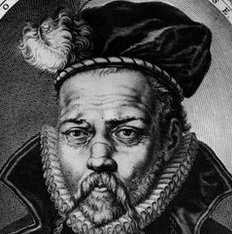
Tycho survived his wound, and took to wearing a false metal nose. Accounts variously give it as made of silver, gold or brass, glued in place with a bottle of paste he carried around. When he was exhumed in the twentieth century green marks were found on his skull, which would indicate that copper was also present in the nose. Tycho returned home after his injury, but despite his father’s wish that he honour his late uncle’s wishes and settle down as a lawyer Tycho managed to persuade him to let him continue his travels. In Augsburg he designed a new instrument for recording the position of stars, and persuaded a patron to underwrite the cost of creating it. It was a quadrant, a revolving device that could accurately measure the position and elevation of a star, larger than any before seen. One of the most remarkable aspects of Tycho’s career is that telescopes had not entered use in astronomy yet, so all his observations were made with the naked eye. His quadrant attracted attention, with notables such as the French philosopher Peter Ramus visiting to discuss astronomy with him. At the end of 1570 he returned home, as his father was ill, and the following summer his father died.
With the family fortune now in his hands, Tycho was able to build his own observatory at Herrevad Abbey, which had been given to his mother’s brother Steen Bille after Denmark had converted to Lutheranism. The abbey had continued to function much as it previously had under the religious rule, acting as a centre of local education and religious services. The monks had even been permitted to stay on, though no new monks had been allowed to join and so they had died out. Tycho and Steen turned the abbey into a scientific centre, with an alchemical laboratory in addition to the observatory. The first paper in Scandinavia was made at Herrevad, and it was here that Tycho had his most famous achievement. On the 11th of November 1572 he noticed a new bright star in the constellation of Cassiopeia, which he named Stella Nova, the New Star. His observations of this would make him the most famous astronomer in Europe, and it is from his name for this star that we take the word that describes it, supernova.
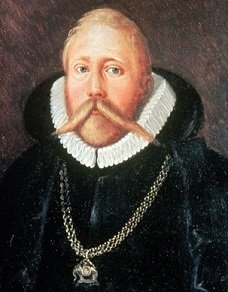
It was also around this time that Tycho began to cohabit with Kirsten Hansen. Kirsten was a preacher’s daughter, and under Danish law she and Tycho could not officially marry. This was because he was a noble, and she was a commoner. However Danish law recognized them as married under common law after three years, with their children counted as legitimate but ineligible to inherit Tycho’s titles. The two would remain together until Tycho’s death, raising several children. Life was not all work and science for the Brahes – Tycho was one of the wealthiest men in Denmark, and entertained to match. One famous story has him keeping a tame moose. This we know of because of a letter where he mentions its death – it had been loaned to another noble, but had drank a lot of beer, fallen down some stairs and broken its leg. The injury had proved unhealable, and so the moose had to be put down.
Tycho was far from the perfect scientist, of course. He proposed a “geo-heliocentric” system for the solar system – where the Earth remained still and the Sun and the Moon revolved around it, while the remaining planets all revolved around the Sun. In later years Johannes Kepler would try to persuade him towards the (correct) heliocentric model, but Tycho refused to credit it because he believed the Earth was too massive to be permanently in motion. While Tycho’s preconceptions often prevented him from realising the truth, his scrupulous methodology could not be faulted, often pointing directly to the conclusion he failed to reach. Perhaps the greatest example of this was in his tests to check for stellar parallax – the variation in a star’s position that would be apparent if the Earth revolved around the sun. He failed to find it, and concluded that either it was not present or the stars were too far away for him to measure it (which is true). When he demonstrated that both the distance to the stars and the size of the stars would have to be immense (and indeed that the sun would have to be a below-average sized star), he dismissed the entire notion as ridiculous – even though he had followed the data to the exactly correct conclusion. Data, too, was often a point of contention – while Tycho had made a huge number of observations, he kept them private and refused to allow other scientists to draw on them.
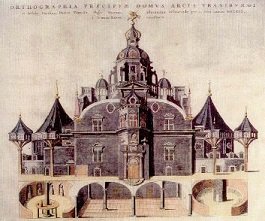
Tycho’s growing fame led him to look beyond the borders of Denmark for places to expand, but the King of Denmark was loathe to give up the fame that having such a scientist within his borders attracted. He offered Tycho an entire island, along with funding to create an observatory there. Tycho accepted and in 1576 construction of Uraniborg (literally ”Castle of Urania”, the Muse of astronomy) was completed. The building became a centre of scientific pursuit, with up to 100 researchers in residence at one point. James VI of Scotland even visited in 1590. Unfortunately for Tycho, however, in 1588 King Frederick died, and his 11 year old son Christian took the throne. Funding continued for Uraniborg until Christian came of age, but as soon as he did he cut it off. Though an agreement had been made that Uraniborg would achieve university status and be passed down to Tycho’s children, when he had a dispute with the young king over the upkeep of his father’s estate the king declared he had no obligation to honour the agreement, and Uraniborg was closed down. It was destroyed only a few years later.
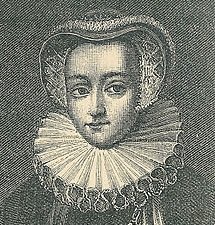
Without his royal patronage Tycho was forced to move abroad, heading to Prague where he came the court astronomer for the Holy Roman Emperor. This was where he worked with Kepler, planning a compendium of all his years of observation to prove the truth of his geo-heliocentric model. Before he could complete it he died. His death was, like his life, somewhat strange. He was at a banquet and despite needing to urinate held to etiquette and remained at the table until his host rose. Unbeknownst to him the pressure of his urine caused his bladder to rupture, and by the time he got home he was in intense pain. He was suffering from uremia, as the urine poisoned his internal organs, and became feverish. His last words, repeated over and over as a calming mantra, were “Let me not seem to have lived in vain”.
Of course, the sudden death of such a figure after a banquet naturally led to rumours of poisoning. Tycho’s rift with King Christian had already left tongues wagging, with some claiming that the real reason for their conflict was that Christian suspected Tycho of having had an affair with his mother, Queen Sophie. Tycho’s death was thus assumed to be the result of poisoning by the King. This rumour gained some acceptance centuries later when Tycho was exhumed in 1901 and scientists claimed to find high levels of mercury in his corpse, though others pointed out that exposure to mercury was one of the basic hazards of alchemy in the 16th and 17th century. Finally in 2010 Tycho was exhumed once more. It took two years of testing, but scientists finally established that the level of mercury in Tycho’s system was not enough to be fatal – and in fact the level dropped in the weeks before his death (with could be tracked by the growth of his hairs), consistent with him having been away from his experiments. Sad as it may be to say it, the great scientist did in fact die of politeness.
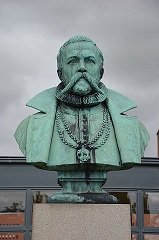
In the aftermath of Tycho’s death, Kepler was able to abstract the data that Tycho had compiled and jealously guarded (by his own admission, taking advantage of Kirsten’s grief to secure it). This data was used by Kepler to prove his own heliocentric model, though the geo-heliocentric model retained a large following. It was finally quashed in 1729, when the English astronomer James Bradley discovered stellar aberration caused by the motion of the Earth around the sun. Tycho’s conclusion may have been flawed, but his dedication to accuracy meant that his data led to the correct conclusion, and the scientific community’s unending respect for him comes from that basis. He may have been wrong on many counts – but in that, at least, he did not live in vain.
Images via wikimedia.
